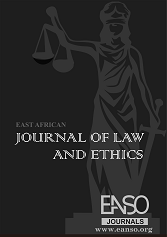Protection of ICRC’s Mandates in Non-International Armed Conflict: A case of States vis-à-vis Non-States Armed Groups
Abstract
The International Committee of Red Cross (ICRC) focuses on giving effect the rules of International Humanitarian Law (IHL) and humanitarian principles generally. In its establishment, the ICRC was given promotive and protective mandates in both armed conflicts namely International Armed Conflicts (IAC) and Non-international Armed Conflicts (NIAC) however; mandates of ICRC in NIAC are much more limited compared to IAC. This means that, the rules of IHL governing NIAC do not provide explicitly the mandates of ICRC. Several states have developed anti-terrorism laws which aid them to fight against terrorism; these anti-terrorism laws developed by states refer NIAC as terrorism and thus, affect the mandates of ICRC during NIAC. States criminalize any organizations from providing any kind of assistance be it of humanitarian nature or not to the armed combatants during NIAC. These include armed combatants of the organized armed groups who are termed as the terrorists in case they are detained by the states armed forces. ICRC staff members have been facing difficulties in performing ICRC’s mandates over the civilians and combatants of the organized armed groups who are under urgent need of humanitarian assistance. States do not guarantee humanitarian activities by ICRC staff members to the so-called terrorists. As the result ICRC is facing accusations of being involved in terrorism. Therefore, in order to perform its mandates, ICRC needs legal access to interact by both State and Non-States Armed Groups (NSAG’s), for issuance of humanitarian assistance to the detained persons and protection of wounded and sick for their reliefs. The article carries with it a reformative agenda as far as mandates of ICRC in NIAC are concerned
Downloads
References
Adele Harmer., Humanitarian Access in Armed Conflict: A Need for the New Principles (Oxford University Press, 2018) p.14.
Cedric Ryngaert., Non-State Actors and International Humanitarian Law Leuven: (Katholieke Universiteit Leuven 2018) p.5.
Felix Schendimann., The Legal Framework of humanitarian access in Armed Conflict, v ol.93 No 884 (2011) p. 12.
ICRC, ICRC engagement with Non-States Armed Group: why how, for what purpose and other salient issue (ICRC 2021).
ICRC, International Humanitarian Law and the Challenges of Contemporary armed conflict: recommitting to the protection in armed conflict on the 70th Anniversary of the Geneva Conventions (ICRC 2019) p. 58.
Nils Melzer., International Humanitarian Law: A Comprehensive Introduction, (ICRC 2019) p. 314.
Sassòli Marco., How Does the Law Protect in War? (ICRC 2011) p.356-363
Watikn, Kenneth., Human in Cross-Hairs: “Targeting and Assassination in Contemporary world Armed Conflict” in New Era Wars, New Laws? edited by David Ardeslay, (Transnational publishers, 2005) p. 141.
Online Sources
ICRC., 77th session, sixth Committee Plenary Meeting on measures to eliminate international terrorism, 2021 Accessed 22nd April.2024. www.icrc.org/en/documents/sixth-committee-plenary-measures-to-eliminate-international-terrorism
Kelley Morgan., “Challenges to Compliance with International Humanitarian Law in the Context of Contemporary Warfare 2018, Independent Study Project (ISP) collection.1618, accessed on 29th June 2024.<https://digitalcollections.sit.edu/isp_collection/1618>
The International Committee of Red Cross, “Counter Terrorism measures can impact humanitarian action negatively” published on 06th October 2022, Accessed on 20th April 2024.www.icrc.org/en/documents/counter-terrorism-measures-can-impact-humanitarian-action-negatively.
Copyright (c) 2024 Ramla Swedy Manga

This work is licensed under a Creative Commons Attribution 4.0 International License.




























